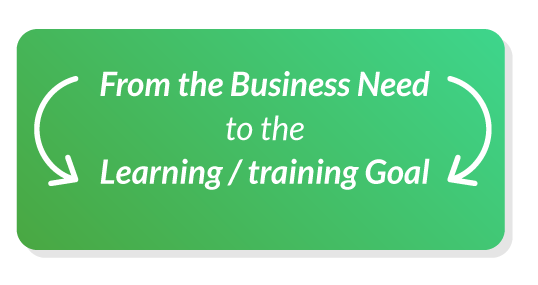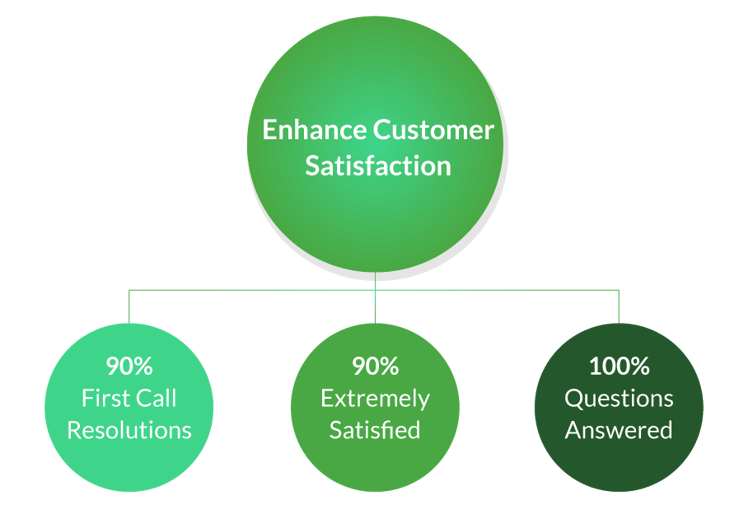The strongest starting point for designing your online training programs is to understand the business needs and desired organizational results that underlie the training initiative, and then create your goals and tracking metrics accordingly.

First Things First: Identify Business Drivers
So, you’ve decided that you need an online training solution for your company.
Where do you go next?
The most important thing to do is to understand the business drivers for your training program. Then, and only then, can you write training goals that are based directly on these business needs.
What are some typical business needs that would prompt the development of an online training program? Glad you asked!
Here are a few examples:
- Improve Operational Efficiency – by achieving greater consistency in process adherence, or increasing efficiency or productivity. Training your employees would be a reasonable solution to this problem.
- Increase Employee Value – by extending employees’ knowledge of an existing skill or training them in new areas. When your employees are skilled in a variety of tasks, they can transition more easily to various roles within your organization.
- Reduce attrition rates – by training your employees in new areas; you can provide career pathways that will keep them from seeking next-level opportunities elsewhere.
- Enhance Customer Satisfaction – by resolving complaints in an efficient and effective manner, and answering questions accurately. Training your customer service representatives to be able to resolve customer complaints during the customers’ first call would be a reasonable expectation and one that can be addressed effectively in an online training program.
Also read: A List of Questions to Help You Draft a Winning eLearning Strategy
If You Measure It, You Can Manage It
Now that you have a good handle on your business needs, the next thing you need to do is write your training goals. It may be an old cliché, but what gets measured generally gets done. Measuring something gives you the data you need to ensure you actually achieve what you set out to do.
So, for example, if you are going to create training to enhance customer satisfaction, you’re going to need a way to measure the current level, and then set a goal for the improvement.

- Business Need: Enhance customer satisfaction.
- Training Goal: Increase the number of complaints that are resolved during customers’ first calls from 50% to 90%, and deliver the kind of care that gets 90% of callers to report that they are “extremely satisfied” on post-call surveys. Also, ensure 100% of customer questions are answered promptly.
Now you have not only aligned your training efforts to your business needs, but you have also set up a process for measuring your effectiveness. When you define goals, you can design training that achieves them.
Another way of stating this principle is, “begin with the end in mind.” That means understanding the bigger vision of what you would like your organization to become, then defining specific online training steps that can get you there.
Finally, there is the matter of accountability. We set goals and measure performance against these goals to hold ourselves accountable for the results – be it success or failure. To do this, we need concrete data that shows us what we did and what the impact was. Only then can we know with certainty what (if anything) we need to do differently.

Measures vs. Metrics
Before we go any further, we should discuss the difference between a “measure” and a “metric.”
- Measure – a quantitative number that counts something, e.g., we trained 100 people on electronic spreadsheets last month, or we made $500,000 in profits last year.
- Metric – a comparison between a measurement to some baseline number, e.g., we trained 100 people, which was 50 more than last month, or we made $500,00 in profits last year, which was $100,000 more than the preceding year.
You need to figure out what you want to know, before you start to measure things. That’s why you start with business goals and then derive your training goals from them.
Metrics for Learning & Development
When you are developing your metrics for Learning & Development (L&D) programs, it is important that you establish benchmarks before the solution is delivered. This is the only way you can reliably measure the results of the intervention. From our earlier example, if you are training your customer service representatives to solve complaints on the first call, then you will need to establish the current resolution rate by either randomly sampling calls or establishing a database.
Feeling at a loss about what metric you can use? Here are a few questions to ask yourself:
- What skills need to be developed? Start by measuring skill levels with an assessment or test before you begin your training to establish a baseline. Then put skill checks inside the training and after the training to document improvements.
- Is training being applied to the workplace? Again, you will need to measure the behavior in question before the training takes place to establish current patterns. Then use the same assessment to measure behaviors after the training has taken place.
- What is the impact on the business as a whole? You will need to involve other departments for this (e.g., IT, HR, or Finance), but it’s well worth the effort to demonstrate the importance of training on the organization.
Also read: Do You Know How Successful Your eLearning Program Really Is?
You should be running your L&D department like a business. Determine relevant business needs, set meaningful goals and metrics to support those needs, and regularly review your progress. Then you will be able to take appropriate corrective action and get back on track as required.



